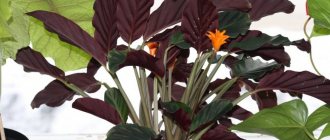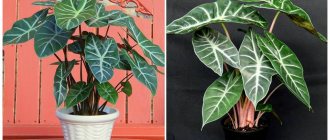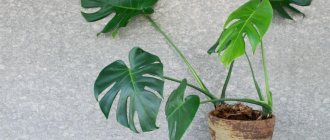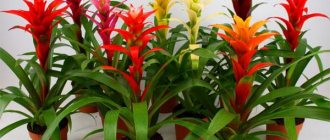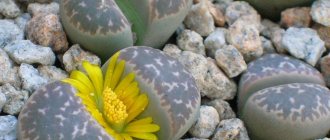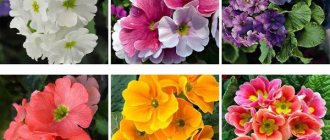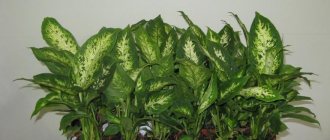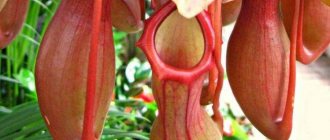Echeveria (Echeveria) or stone rose is a succulent, a representative of the large Crassulaceae family. Named after the artist Atanasio Echeverría Coda, who illustrated stories about Mexican vegetation.
This plant attracts the attention of flower lovers with its unpretentiousness and original appearance, for which it is nicknamed the stone rose. It is represented by a rosette (its diameter ranges from 3 to 40 centimeters), formed by spirally arranged fleshy leaves and resembling a rose. The surface of the leaves is covered with a waxy coating or velvety fluff that protects against moisture evaporation. The leaves can have a variety of colors: green, light green, almost white, burgundy.
In nature, echeveria grows on the plains and mountains of Mexico and Peru, where summers are very hot and winters are warm.
Typically, stone rose blooms in spring and summer, but some varieties delight with abundant and long-lasting (about a month) flowering in the winter months. Bell-shaped flowers (white-cream, lemon, yellow, coral, orange, pink, scarlet) rise on an elongated peduncle reaching 90 centimeters in height. They form inflorescences in the form of panicles or spikelets.
The stone rose in combination with other succulents looks original on an alpine hill.
What does echeveria look like?
The genus Echeveria is part of the Crassulaceae family. In total, according to various sources, there are from 150 to 180 species of these succulents in nature. The homeland of most of them is Mexico and the southern states of the USA, but some representatives can also be found in South America (Peru). The plant prefers low mountains and plains, where in summer almost all days are hot and sunny, and in winter, if there are frosts, they are very infrequent and insignificant.
The genus was named in honor of the 19th century Mexican artist Atanasio Echeverría Godoy, who, in addition to his main activity, was interested in botany, compiling and illustrating books dedicated to the flora of his homeland.
The collection of echeverias is guaranteed not to go unnoticed
A characteristic feature is the ability for interspecific crossing. Pachiveria (a hybrid with pachyphytum) and Graptoveria (with graptopetalum) were obtained through selection.
All echeverias are typical succulents. These are evergreen herbaceous or semi-shrub perennials that do not have a stem. It is replaced by a thick, short, fleshy, intensively branching trunk. The main thing that gardeners value Echeveria for is its leaves. They are also fleshy, even, smooth to the touch. A characteristic feature is a layer of whitish, silvery or grayish coating or velvety pubescence to the touch. This is protection from the scorching sun. Moreover, the hotter it is outside, the thicker the layer becomes. Because of this, it turns blue, and a noticeable reddish border appears along the edges of the leaves.
The leaves, arranged often and strictly in a spiral, form dense rosettes. From a distance they can easily be mistaken for flowers. The illusion is supported by an unusual coloring - pale green, with a slight lilac, red, gray tint. Because of this, echeveria has earned its unofficial popular name - “stone rose” or “stone flower”.
A rosette of echeveria leaves looks like a flower from afar
In nature, the leaves reach sizes of 3–30 cm in length and 1.5–15 cm in width. At home, the parameters are approximately twice as modest.
The peduncle of echeveria is much taller than the plant itself. Growing from the middle of the rosette, depending on the type, it can reach 35–85 cm. The inflorescence is in the form of a brush, spike or umbrella, with many flowers resembling very small bells. All shades of yellow and orange predominate, sometimes with a greenish or reddish tint. The outside color is a little brighter than the inside. In nature, echeveria blooms in late spring or summer, with the exception of a few species that prefer to do so in mid-winter. Flowering is quite long - 15–20 days. If natural or artificial pollination has occurred, fruit-boxes with five nests are formed, in which small, dull brown seeds ripen.
Echeveria flowers are quite pretty
The roots of the plant are located almost on the surface - this makes it easier and faster to absorb moisture. The root system is fibrous and branched.
Differences from young
Due to its external similarity, Echeveria is often confused with another plant belonging to the Crassulaceae family - sempervivum (popularly known as tenacious or young). However, unlike it, echeverias have an extremely negative attitude towards any cold weather.
Sempervivum leaves look thinner, more graceful, sometimes they may even seem translucent, and the rosettes are smaller in size. Even adult specimens of juveniles do not form stems. The sockets seem to lie on the ground. Echeveria, especially with a lack of light and heat, is capable of stretching. The lower leaves fall off and the rosette rises up.
To leave no doubt at all, you need to wait for the offspring to appear. In echeveria, “babies” develop only at the base of the stem. For this purpose, the young produce “whiskers”, at the ends of which offspring are formed.
Echeveria and Juvenile belong to the same family and are quite similar, but there are several distinctive features
Types grown at home (table)
Of the many representatives of the species, most are suitable for indoor floriculture. But for various reasons, only a few dozen are the most common.
| View | Description |
| Agave (agavoides) | The stem of this bush-like plant, reaching 25–30 cm in height, is very short or completely absent. The leaves are delicately lettuce, translucent at the edges, with a noticeable reddish tint. At home, the leaf length is 4–10 cm, width is 5–6 cm. The plant blooms in late spring. The flowers are very small (1–1.5 cm), all shades of yellow-red. Very rarely, several inflorescences have pink coloring. |
| White-haired (leucotricha) | The name of the subshrub is due to the presence of a thick white edge, reminiscent of a long pile. Small (12–15 cm in diameter) rosettes are composed of lancet-shaped leaves with a brownish border. The flowers are bright red. Artists know this shade as cinnabar. |
| Shiny (fulgens) | A characteristic feature of the subshrub is not too intense branching. If shoots are formed, they are short and very thick. Inflorescence in the shape of a brush or umbrella. Bright scarlet flowers appear in late winter or early spring. |
| Gibbiflora | Of all the echeverias, it most closely resembles a tree. Stems are erect, sometimes slightly branched. Rosettes of grayish-green leaves with a brick or brown tint are located on the tops of the shoots. The leaf plate is similar to a lens - it is concave at the top and convex at the bottom. The leaves are large - 20–25 cm long, 10–15 cm wide. At the end of summer, the plant produces a tall (up to 1 m) peduncle. Inflorescence in the shape of a spike. The flowers are muted scarlet on the outside, yellowish on the inside. Many hybrids have been bred through selection. The most famous are carunculata (the leaves are covered with small tubercles, as if twisted), crispata (the leaves with corrugated edges are silvery) and metallica (leaves with a whitish or reddish border have a tint of old bronze or purple). |
| Derenbergii | Herbaceous plant. The shoots spread along the ground, small (4–7 cm) rosettes of leaves are located at their tops. The length of the leaf is almost equal to the width (3 and 2.5 cm). The leaves are covered with a bluish coating, with a reddish tint visible along the edges and at the tip. The inflorescences are short (5–6 cm), spike-shaped. The flowers are yellow-orange or reddish. |
| Elegant | Herbaceous perennials. The leaves are a very light green shade, almost white. The edges are see-through. The tip is pointed, sometimes even prickly. A characteristic feature is a highly branched peduncle. The inflorescences are drooping, in the form of small one-sided racemes. Flowers are crimson, turning yellow. |
| Lau (Lauii) | Unlike other species, it does not grow too quickly and is quite demanding in care. One of the largest rosettes (18–20 cm in diameter). The leaves are diamond-shaped, almost white due to a thick layer of waxy coating. The orange-pink shiny flowers are also covered with it. |
| Pillow-shaped (pulvinata) | Low-growing (18–20 cm) subshrubs. The rosette is quite “loose”, there are few leaves in it. At the top of each leaf there is a short spine. The leaves and yellow-red flowers are pubescent. Inflorescences are spike-shaped. |
| Shaw (Shaviana) | Not too similar to echeveria at all. The leaves are almost round, soft to the touch, corrugated along the edges. They are compressed so that the rosette looks more like a head of cabbage rather than a flower. It produces several flower stalks at the same time, the pinkish flowers on which bloom alternately. |
| Bristly (setosa) | The bush-like plant forms many shoots. The rosettes are in the shape of an almost regular ball, each of them has more than a hundred dark green leaves with a grayish tint. The leaves are densely covered with white bristles - hence the name. The inflorescence is low - about 30 cm. The shape of the flowers resembles miniature tulips, and the color too. |
| Linguaefolia | A low (20–25 cm) subshrub forms two (no more and no less) fleshy trunks. The peduncle is drooping, sometimes branches from below. The flowers are light yellow, straw-colored. |
| Purple (atoropurpurea) | The rosette is large, but loose. It is located at the top of a stem about 15 cm high. The leaves are also large (up to 12 cm), brick-colored. |
| Purple (purpusorum) | Very original color and shape of the leaves. They are thick, wide, with a very sharp end, becoming noticeably thinner towards the edges. The rosette is located at the top of a short thick stem. The leaves are olive, with rich purple spots. |
| Echeveria Harmsii | The leaves are very small, in the shape of a rounded diamond. At each point, the leaf blade turns red. The flowers are small, reddish-yellow. |
| Desmetiana | The leaves have a pronounced bluish tint. The rosette is located at the top of a long stem. Blooms from mid-July. Inflorescences are formed on the side shoots. |
| Multi-stemmed (multicaulis) | Tall stem (up to 1 m). The leaves are small, slightly concave, dark green, with a red border. The rosette in the center is dense, becoming noticeably looser towards the edges. The flowers are yellowish inside, scarlet outside. |
| Gray (glauca) | Compact plant with small dense rosettes. The leaves are wedge-shaped at the base and become pointed towards the tip. They are covered with a thick layer of bluish coating. |
| Miranda | A very impressive plant with neat small rosettes that seem to be lying on the ground. They are very similar in shape to a lotus. Varieties with bluish, violet, pink, scarlet, yellowish, and silvery leaves have been bred through selection. |
| Black Prince | Selective hybrid. The leaves are green at the base and change color to dark purple at the tips. From a distance it can even be mistaken for black. The flowers are small and scarlet. |
| Pearl of Nuremberg (Perle von Nurnberg) | Selective hybrid. The stem is thick and straight. The leaves are pinkish-gray, the youngest ones are pastel pink. The flowers are muted scarlet. |
Photo gallery: Echeveria varieties
The youngest leaves of Echeveria Brilliant sometimes have notched edges. Echeveria White-haired blooms profusely throughout the spring. Echeveria hump-flowered is an excellent basis for breeders’ experiments. The reddish tint of the leaves of Echeveria Agave-shaped becomes richer as the plant matures. Because of its decorative nature, Echeveria Miranda is most often found in indoor floriculture Echeveria Purple cannot be confused with other species of Echeveria Multistem intensively branches from the very base Echeveria Black Prince is one of the most beautiful breeding hybrids Echeveria Purple is actually not quite purple, but it sounds beautiful Because of the thick layer of bloom, the leaves of Echeveria Sizoy seem almost white Echeveria The pearl of Nuremberg was bred on the basis of Echeveria humpbacked flower The stem of Echeveria Garms practically does not branch Echeveria Bristleflowers blooms very profusely If the winter was warm, in nature the flowering of Echeveria Tongue-shaped can move from April to January or February The bottom leaf plate of Echeveria Cushion-shaped is slightly convex Echeveria Desmeta is one of the most enduring in relation to the lack of light and excess moisture The waxy coating on the leaves of Echeveria Lau is thick, but is easily erased Over time, the stem of Echeveria Graceful lies under the weight of the leaves, the rosette quickly takes root. Unlike the others, Echeveria Derenberg has only 3-5 flowers in the inflorescence. In winter, Echeveria Sho, will most likely lose most of its leaves
Botanical description
The echeveria succulent forms dense rosettes with a diameter of 3 to 40 cm from fleshy, juicy, hard, moisture-filled leaves. Representatives of the genus can be stemless or have long shoots; the leaves of different types of echeveria differ in shape, color and size. Five-membered small yellow, red-brown or red-orange flowers with succulent sepals and petals, collected in an erect lateral inflorescence, are located on a long lateral or vertical peduncle.
The intensity of a flower's color often depends on the quality of the light: flowers developed in cloudy weather are usually yellow, while those formed under the sun have a red tint.
Echeverias form interspecific and intergeneric forms well, of which the most famous are sediveria, pachiveria and graptoveria. Echeveria is widespread in indoor culture.
- Beneficial properties of aloe
Creating optimal conditions
Echeveria is a relatively undemanding plant, but if you do not put in a minimum of effort and create more or less suitable conditions for it, the decorative value of the flower will sharply decrease.
Table: optimal conditions
| Factor | Optimal conditions |
| Location | A window facing south, southeast or southwest is suitable for the plant. In summer, it is useful to take the pot out onto an open balcony or veranda, taking care to protect it from sharp cold drafts and precipitation. You can add some zest to your garden design by temporarily planting echeveria in an alpine hill. |
| Lighting | Echeveria is extremely photophilous and tolerates direct sunlight well. In bright light it only becomes more decorative - a thickening layer of waxy coating gives the leaves a beautiful bluish tint, and a reddish border appears along the edge. The leaves may wrinkle slightly, but this is completely normal. Specimens that have just been acquired or have survived a dormant period gradually adapt to the bright sun. |
| Temperature | In nature, echeveria can survive temperatures up to 40ºС, but the optimal parameters are 23–28ºС. For the winter, it is best to put the flower in a room with a constant temperature of 7–10ºС. But, in principle, it is able to overwinter at standard 18–20ºС, which is maintained in the cold season in most apartments. The plant does not respond to small changes in temperature. |
| Air humidity | For echeveria, this parameter is unimportant. It does not need additional spraying even on the hottest days. On the contrary, in variegated varieties and bright hybrids, the color of the leaves may turn pale and fade from excess moisture. A standard humidity level of 40–60% is sufficient. |
Alpine slide with echeverias - a wonderful garden decoration
Features of plant flowering
Echeveria - species: agave, Pulidonis, Black Prince, Purpuzorum, Lilacina
Some hybrids require special conditions, otherwise they will not bloom.
Important! Echeverias in mixes (small size) are usually used to create flower ensembles.
Blooming succulent
Period of activity and rest
In the spring and summer months, echeveria blooms for 14-30 days. In winter, most of the representatives of the genus retire. At this time, the regime is seriously changed: the temperature is reduced to 8-15 ℃ and irrigation is reduced to one procedure per month.
Types and shape of flowers
Small buds are located in inflorescences located on a vertical lateral peduncle. The tone of the petals depends on the lighting conditions:
- lack of sun causes yellowness;
- a sufficient amount - a reddish or orange tint.
At the end of the budding period, babies are formed on the peduncles.
Transplant procedure
To preserve their decorative properties, it is recommended to replant young echeverias every year after the end of the dormant period. For adults, one transplant every 2–3 years is enough; during breaks, you can simply remove the top 1–2 cm of soil and replace it with fresh one. Transplantation procedures can be avoided if they are grown hydroponically.
The plant is undemanding to soil. It should not be too nutritious, light and loose. Standard soil for succulents is quite suitable. However, experienced gardeners prepare the substrate themselves, mixing fertile turf soil, coarse river sand in equal proportions and adding a glass of sifted wood ash and fine red brick chips for every 3 liters of soil. Or another option - turf soil, powdered clay with sand and twice as much universal soil for decorative foliage indoor plants mixed in equal proportions. If you take soil from your own plot, find out the acidity level in advance. Acidic soil is not suitable for echeveria.
Since the root system of echeveria is shallow and branched, choose a bowl-like pot - low but wide. A mandatory requirement is a large drainage hole. At least a quarter of the volume should be occupied by drainage made of expanded clay, pebbles, ceramic shards, and brick chips. There is no need to significantly increase the volume of the pot compared to the previous one. A difference in diameter of 2–3 cm is quite enough. Ideally, the pot should be ceramic and light-colored so that it does not heat up so much in direct sunlight.
A deep pot of echeveria is not needed
When replanting, pay special attention to touching the leaves as little as possible. The protective coating on them is very easy to accidentally wipe off.
You also need to carefully examine the roots and use a sharp, disinfected knife to cut off any dried, dead or rotted ones. Remove with reserve, capturing another 2-3 cm of the root, which appears healthy. Immediately sprinkle the sections with powdered activated carbon.
Before transplanting, the soil should be slightly moistened with a spray bottle and slowly absorbing fertilizer in the form of sticks should be inserted into the earthen ball. The transplanted echeveria is watered moderately. Watering will no longer be needed in the next week. It is being resumed gradually.
Echeverias grow well in florariums
Classification
The systematization of Echeveria species is quite extensive. The varieties of this plant are divided according to the following criteria:
- by structure - there are varieties with dense or loose rosettes;
- by the color of the plates - the leaves of the hybrids are characterized by different colors, these can be all shades of green, pink, purple, red;
- according to the root system - the roots of the plant are both superficial and thread-like;
- along the stem - there are varieties with a rosette growing from the soil, or creeping when it rises above the ground;
- by the color of the leaves under special lighting - red or yellow.
Necessary care
In its homeland, echeveria grows quietly under the scorching sun on rocky soils. Accordingly, it does not need either abundant watering or frequent fertilization. The main thing is not to flood or overfeed the flower.
Watering
In spring and summer, echeverias are watered on average once every 7-10 days, depending on the weather outside and the type of plant. The thicker the pubescence, the less it needs moisture. Be sure to take soft water that has stood for at least a day, ideally distilled or filtered.
The earthen lump should dry well from the previous time, but it is undesirable to bring the plant to a state where the soil begins to move away from the edges of the pot. Another sign of lack of moisture is wrinkles on the leaves.
Starting in August, watering is gradually reduced, preparing the plant for the dormant period. The interval is approximately doubled.
Avoid getting water inside the rosette and on the leaves themselves. In the first case, rotting may begin, in the second, sunburn is very likely. It is best to use bottom watering, pouring water into the tray of the pot and draining the excess after 15–20 minutes.
Top dressing
In the phase of intensive growth of echeveria, one feeding per month is enough. To do this, prepare a solution of liquid mineral fertilizer for cacti and succulents. The proportion recommended by the manufacturer is halved. Fertilizer is added to water for irrigation.
Rest period
Echeveria needs a fairly long dormant period, which lasts from mid-autumn to the end of winter. During this time, the flower is transferred to a cool, bright place with a temperature of 7–10ºС, watering is reduced to once a month and is not fertilized at all.
In principle, echeveria will overwinter in standard apartment conditions, but in this case, most likely, there will be no flowering. If you leave the flower in the same room, more frequent watering will be required. Drooping, wilted leaves serve as a signal that it’s time. Specimens that bloom in winter are also kept warm.
Bloom
If the dormant period was organized according to all the rules, echeveria will bloom in spring or summer (with the exception of some species in which this occurs in winter).
Taking advantage of the fact that the flower belongs to the category of short-day plants, you can “deceive” nature and achieve flowering at the right time. For this echeveria to be 50–60 days older than one year, special conditions must be created: lighting for 12–13 hours daily and a temperature of 16–18ºС.
Video: how to care for echeveria
Mix of stone roses
Some gardeners have Echeveria mix, which is a combination of several different varieties and varieties of Mexican succulent. The flower arrangement is very elegant, colorful and unusual.
An unusual and graceful plant can be found in hot Mexico. Echeveria is an unpretentious succulent. You can grow the flower both at home and outside, since the stone succulent looks great in landscape design. The stone rose has a beautiful decorative shape and is very much appreciated by flower growers.
Common mistakes in care
Echeveria, of course, is not picky and undemanding, but mistakes in care have a detrimental effect on its decorative properties.
Table: common mistakes
| Description of the problem | Probable Cause |
| Dark spots on leaves. | Drops of water got on the plant or you yourself erased the wax coating, for example, during transplantation. |
| The leaves and stem at the base turn black and are easily separated from the plant. | The echeveria is too cold and/or you are watering it too much. If more suitable conditions are not created, rot that begins to develop will quickly destroy the plant. |
| Leaf deformation. | Exceeding the permissible concentration of fertilizers or using hard water for irrigation. Another option is a reaction to insecticides. If possible, use only those whose main active ingredient is pyrethrum. |
| The stems become elongated, the leaves turn pale, and the rosettes become less dense. | The plant lacks light and warmth. Find him a more suitable place and gradually (over 10–12 days) accustom him to new conditions. |
| The leaves are getting smaller. | Echeveria is cramped in a pot. After the next dormant period, replant the plant. This is also a characteristic sign of insufficient or too infrequent watering. |
Echeverias react quite negatively to mistakes in care, losing their decorative properties.
Diseases and pests
Echeveria, due to its fairly dense leaves, is quite resistant to damage by most pests. However, it often suffers from all types of rot, which succulents are susceptible to with too much watering.
Table: diseases and pests of echeveria
| Disease or pest | Symptoms | Prevention and control measures |
| Mealybug | The pest is easily identified by the small dirty white pellets, similar to cotton wool or poplar fluff, which it leaves at the base of the stem and leaves. If measures are not taken, all the leaves will become covered with a continuous whitish coating, then they will turn yellow and fall off. |
|
| Root mealybug | Pests penetrate the roots of plants and suck out the juices. The problem can only be accurately identified during transplantation. Before this, one can only note that the plant stops growing, the leaves gradually turn pale, turn yellow and wrinkle. A waxy gray-white coating is visible along the edge of the pot. |
|
| Root-knot nematodes | Nematodes are small worms that suck sap from roots. As a result, swellings appear on them, in which pests live and reproduce. If no action is taken, they will destroy the entire root system and the plant will die. | Since nematodes are very difficult to control, the focus is on prevention.
|
| Root rot | The roots become loose and soft to the touch and turn black. The same can be said about the base of the stem and leaves. The leaves become smaller, turn yellow and fall off, and the plant dies. | It is impossible to save a badly damaged echeveria; it can only be thrown away, after leaving the healthiest parts for further rooting.
|
Photo gallery: Echeveria diseases and pests
Root rot is very dangerous for all succulents Root-knot nematodes can destroy the entire root system in a matter of days Root bugs are difficult to identify without removing the plant from the pot Mealybugs are easy to identify, but difficult to get rid of
How does Echeveria reproduce?
Echeveria is easily propagated by almost all known methods.
Rooting cuttings and rosettes
The most reliable way to get a new echeveria is through a daughter rosette. But not in all species they often form at home. Therefore, in semi-shrub plants, you can cut off the side shoot or top (the optimal length is about 10 cm).
When separating offspring, try not to harm the plant.
The rooting procedure looks like this:
- When replanting again, using a sharp knife, trying to injure the plant as little as possible, cut off the daughter rosette or cuttings. Sprinkle the cut with crushed activated carbon.
- Carefully break off the lower leaves, exposing 2-3 cm of the stem. Wrap in a paper napkin or place in a glass so that the cut does not touch anything, and leave in the open air. The minimum period is 10–12 hours. For plants with thick, fleshy stems, drying may take several days or even a week.
- Stick the planting material vertically into pots filled with a mixture of leaf soil and coarse sand (2:1). Lightly compact the soil. You can also mix equal parts sand and vermiculite.
- After a day or two, water the plant with water whose temperature is 2–3ºС higher than room temperature. Further watering - as the substrate dries. Rooting of cuttings occurs within 7–10 days.
Echeveria offspring take root quite easily
Rooting leaves
From the shoot below, you need to separate a healthy leaf without the slightest trace of deformation, signs of damage by pests and other pathologies and dry it for 8–10 hours.
In mid-spring or early summer, it is placed cut down in coarse sand or a mixture of dry peat and cactus soil in equal proportions. When the cut site dries out, a growth bud appears, from which young echeveria is formed. 3–4 months for rooting is normal. It can be reduced by creating a constant temperature for the plant of 23–25ºС.
After about a month, when the mother leaf has completely dried out, the resulting plants can be transplanted into the ground. Care for them as you would for cuttings.
You can root a leaf obtained from any echeveria.
Germination of seeds
Echeveria seeds at home appear only after artificial pollination. If successful, you need to wait until the fruit-box bursts at the seams.
At the end of winter or early spring, the collected planting material is laid out on the surface of the soil in shallow containers filled with sand and dry peat in a 1:1 ratio. To speed up the emergence of seedlings, some gardeners recommend wrapping the seeds in cloth and keeping them in moist peat for 2-3 days.
To create a greenhouse effect, the containers are covered with glass or plastic film. As the substrate dries, it is moistened, and the plantings are ventilated daily. The optimal temperature is 20–23ºС. Under these conditions, seedlings will appear in 12–18 days.
After the formation of three true leaves, the seedlings are planted in separate containers filled with a mixture of leaf soil or universal soil for indoor plants and sand in a 2:1 ratio.
Echeveria seedlings need to be transplanted after 3–4 months
When the new rosettes reach a diameter of 3–4 cm, they are transplanted into small pots. In the future, they are cared for in the same way as for adult echeverias.
Video: propagation of echeveria
Methods for propagating a flower, when is it best to do it
You can propagate a flower in several ways. The preferred options for propagating echeveria include increasing the number of leaves or rosettes.
Echeveria leaf propagation
Select the healthiest foliage and separate it from the stem. After drying for a week, the outer side is laid out on a pre-moistened substrate and kept until roots appear at +25 ℃. When the first rosettes are formed, they are placed in separate containers.
Important! Specimens that respond well to leaf propagation include Echeveria Pearl of Nuremberg. It takes root well with rare substrate moisture and maximum illumination.
Leaf propagation
Reproduction by rosettes
It is the preferred option and involves the separation of a daughter specimen from the mother. After cutting, the area is treated with crushed charcoal (charcoal or activated) and dried for about 12 hours. The rosette is planted in pre-moistened soil and waits for its own root system to emerge. Correct implementation of the technique helps speed up the formation of buds.

